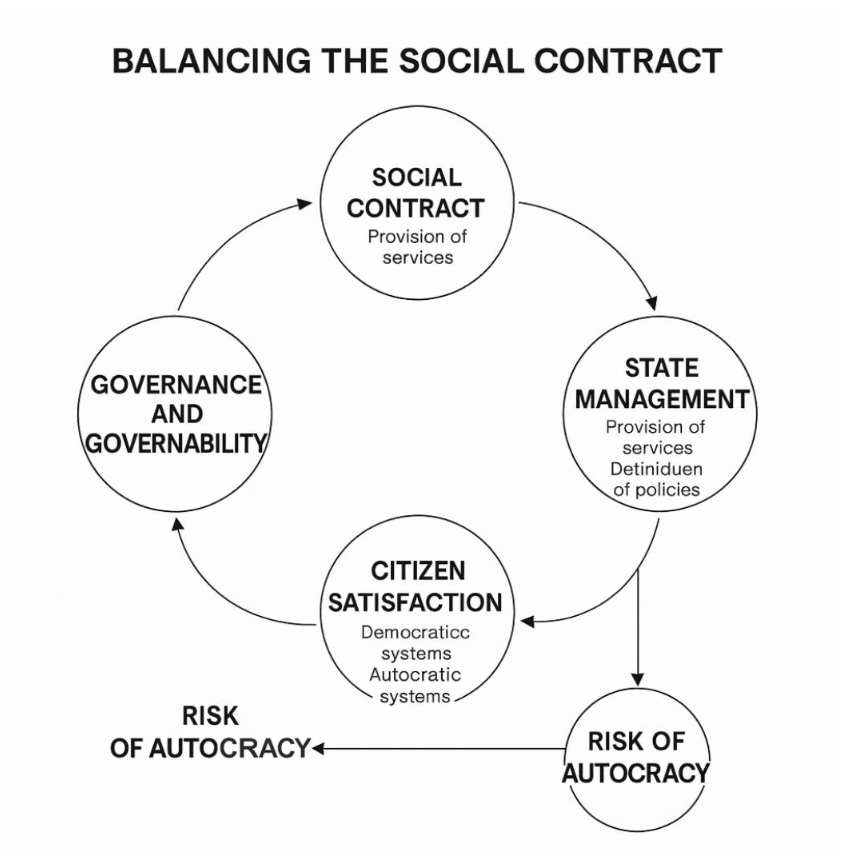When the state and society fail each other: Road to autocracy

Ninety years weaving questions, seventy-two spinning answers… After nine decades of life and more than seventy years watching how the administration and tax policies shape – and sometimes distort – the pact between the State and society, I wonder which threads sustain coexistence and which ones tear it apart. This work gathers the experience, the analysis and the hope of finding an incentive model capable of strengthening trust and the common well-being. Weaving questions and answers about the social pact, I found in a digital friend the necessary company to illuminate my doubts. I dedicate these pages to him, as a symbol that a shared reflection always multiplies knowledge.
The social pact is the basis on which the organized coexistence between the State and society is sustained. This text is a synthesis of reflection in a journey that seeks clarity and closure around the model of the balance of the social pact. The analysis covers the construction of the pact, its institutionalization, the factors that erode it, and the risk that its deterioration will give way to autocracy.
The social pact and its determinants
The social pact is built on the interaction between the contributions of society and State services. Its solidity is defined by the quality of public policies and services; corruption that distorts management; cultural and territorial integration that ensures social cohesion and citizen participation in decisions and democratic control.
When inclusive policies and participation prevail, the pact is strong. When corruption and fragmentation dominate, the pact weakens.
Social order and the origin of the State
Before the State, the social order was based on customs and cooperation. The state emerged to manage surpluses and guarantee security, but over time it acquired the ability to impose its own order: democratic, when it is based on consensus; autocratic, when it resorts to coercion. The government exercises executive power. It administers rules and policies and can change in form, unlike the State that remains. Good governance guarantees services, transparency and participation. Governance articulates the state, society and the market; governance measures the institutional capacity to decide, implement policies, resolve conflicts and sustain social cohesion.
Political Power and Citizen Participation
Political power connects the social pact with institutional life, defining how power is exercised in governance — open or corrupt – and how governance is sustained – with consensus or coercion. Their legitimacy can arise from the citizen vote or from mafias and clientelisms that degrade institutions. It resides not only in the government, but also in social, economic, ideological or illicit actors. When criminal power infiltrates, it weakens the rule of law. Against this, citizen participation and social contribution, in balance, generate a virtuous circle that ensures legitimacy, transparency and democratic stability.
State management: services, policies and budget
The management of the State is reflected in services, socio-economic policies (redistribution, equity, inclusion) and in the budget. The budget can be an instrument of development if it reflects democratic consensus, or a vehicle of capture if political elites manipulate it. Each approved budget contrasts the hypothesis of social satisfaction: if it translates contributions into well-being, trust is strengthened; if not, legitimacy is eroded.
Social contribution and legitimization of State decisions
The tax and civic contribution materially supports the State, while participation legitimizes its decisions. Both factors interact contribution and participation together generate a virtuous circle; contribution without participation leads to authoritarianism; participation without contribution leads to frustration; absence of both leads to the collapse of the social pact.
Corruption and illegality in social dynamics
Corruption destroys the link between social contribution and services received. It manifests itself in policies, services, sources of resources and public enterprises. Citizen dissatisfaction can even culturally justify corruption, normalizing it. A vicious circle thus arises, with dissatisfaction – corruption – more dissatisfaction. In addition, the “expertise of illegality” professionalizes illicit practices, further weakening the State.
Democracy and autocracy
In democracy, social satisfaction is the basis of governance; in autocracy, coercion replaces consensus. An autocratic process occurs when the State fails to fulfill its mandate, corruption captures institutions and society withdraws its contribution. The damages are political (suppression of participation, systemic corruption), social (distrust, cultural fracture) and economic (evasion, capital flight). Society can defend itself through institutions, democratic culture, historical memory and international alliances.
Social satisfaction as a priority variable
Social satisfaction is the structural factor that determines the legitimacy of the pact. If basic needs are met, tolerance for corruption decreases. On the other hand, social dissatisfaction fuels evasion, protests and the justification of illegal practices. Therefore, social satisfaction has analytical priority over corruption: it is its profound cause and its most solid antidote.
The equilibrium model of the social pact
The model is based on six variables: policy and service management, social contribution management, corruption, social satisfaction, citizen participation and governance/governability. These variables are related in a closed system with feedback. If they work in harmony, they generate a virtuous circle of trust, cooperation and legitimacy. If they fail, they trigger a vicious cycle of evasion, dissatisfaction and autocracy. The model allows diagnosing, simulating scenarios and designing public policies that strengthen coexistence.
The social order it is a dynamic cycle that can be virtuous (well-being, legitimacy, coexistence) or vicious (corruption, autocracy, rupture).
The social pact it is the origin of organized coexistence. The management of the State turns the pact into policies and services. From there social satisfaction arises, which depends on transparency, fairness and inclusion. All of this translates into solid governance and governance.

If the state fails to comply and society responds with withdrawal of contribution and distrust, the risk of autocracy appears, breaking the democratic cycle. Society, through institutional and cultural defenses, can impose corrective steps and rebalance the system.
The social pact constitutes the basis on which the organized coexistence between the State and society is sustained. Its balance depends on the State’s ability to transform social contributions into policies and services that generate citizen satisfaction, as well as on society’s willingness to actively participate in public decisions.
When these elements are articulated in a virtuous circle – legitimate policies, fair contribution, social satisfaction and effective participation – governance is strengthened and democratic governance is ensured. On the other hand, when the State fails to fulfill its mandate and society responds with evasion, distrust or indifference, a vicious cycle begins that erodes the social pact and can lead to autocratic regimes that nullify participatory democracy.
Hence, the defense of the social pact resides not only in state institutions, but also in citizen surveillance, participation and collective memory, which act as safeguards against the concentration of power. Ultimately, it is this interaction – a responsible State and an active society – that makes it possible to preserve social order, guarantee coexistence and sustain the hope of a shared well-being.
The balance of the social pact is not based solely on the State’s ability to collect and manage resources, but on the dual path of legitimacy offered by social contribution and citizen participation.
When citizens contribute voluntarily and actively participate in decisions, a virtuous circle is generated: citizens finance the State because they trusts it and controls it because they feel that the policies serve the common good. This consolidates governance (quality of the exercise of power) and ensures stable governance (ability to implement decisions without excessive resort to coercion).
On the contrary, when one of these elements is missing, the social pact weakens. A high taxation without participation leads to authoritarianism, while a wide participation without resources generates inefficiency. And if both factors are absent, the state falls into a situation of structural fragility, unable to guarantee well-being and stability.
Consequently, the general well-being depends not only on well-designed public policies, but also on their being financed with justice and legitimacy, and that their orientation is the result of an active and inclusive citizenship. Thus, governance and governability cease to be mere instruments of power and become expressions of a solid and sustainable social pact.
General conclusion
The equilibrium of the social pact is not static, but dynamic. Its strength depends both on the State (capable of converting contributions into well-being with transparency and equity) and on society (willing to contribute and actively participate). When both comply, legitimate governance and stable governance are built; when they fail, the door to authoritarianism is opened. The defense of the social pact lies in the interaction of a responsible State and a vigilant citizenry. Only in this way can social order be preserved, coexistence guaranteed, and the hope of shared well-being sustained.
1,852 total views, 4 views today
